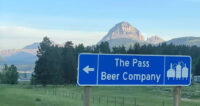The ‘big lie’ of borders addressed in speaker series
By Lethbridge Herald on December 5, 2023.
Theodora MacLeod – LETHBRIDGE HERALD – Local Journalism Initiative Reporter
What do the Suez Crisis, troubles in Ireland, Indo-Pakistani conflict and Russia’s invasion of Ukraine have in common?
Borders. These examples, like many international conflicts throughout history, were and are– at their core– about national land ownership and territory rights, upheld by invisible, manmade boundaries.
For more than 25 years, Sheila McManus, professor of history at the University of Lethbridge, has been studying borders and borderlands, specifically the western North American borders on either side of the United States – the 49th parallel and the U.S-Mexico border.
As part of the PUBlic Professor series, McManus recently spoke at the Sandman Signature Lethbridge Lodge, declaring her stance that “Borders are stupid.”
“I started my Ph.D. research in the 90s when everyone was like ‘oh, globalization, and NAFTA and free trade and a borderless universe.’ and then 9/11 happens. There was a re-securitization of, not just North America’s borders, but globally borders in the aftermath of that,” McManus explains, adding that while many North Americans might associate walls at border crossings with the Trumpian chants to “Build the wall,” in 2016, there has been a drastic uptick in physical barriers such as walls and fences being built at borders across the world in the last 20 years.
“What’s going on in the 21st century that we feel the need to rebuild, reinforce walls and fences and horrifically violent immigration policies?” McManus asks rhetorically, later explaining that border fencing along the U.S and Mexico border began as an attempt to keep cattle from crossing national boundaries but has evolved to be the deadliest land border in the world for migrants crossing. The International Organization for Migration documented 686 disappearances and deaths at the crossing in 2022 alone.
“These lines have consequences.” McManus says.
“For decades the border patrol has been happily letting people die of thirst in the desert, literally withholding water. Destroying water caches that were put along the way, sexually assaulting women who are crossing,”
But with or without a wall or fence, what exactly is a border aside from being the subject of McManus research? “They are these imaginary lines, they have made them up, and then we get people to believe in them by attaching concepts like sovereignty and national identities onto them.” McManus continues, “The 49th parallel is an invisible line that somebody chose a couple hundred years ago.”
But McManus believes that the issue goes far beyond the arbitrary nature of territorial boundaries. It allows for nations to abdicate responsibility.
“I don’t think we can address issues like climate change without a transnational global response. Clarifying, McManus says “individual nations can’t sit back and say ‘well this initiative is going to be bad for my national economy… And therefore, all of you climate migrant refugees whose home is disappearing under the rising ocean, you’re not my problem.’ What if they are, actually, our problem?”
McManus says that as people’s homes and livelihoods disappear due to climate change, it is irresponsible for economically and politically powerful countries to sit back and deflect accountability, especially when these countries have gained from environmentally exploitative practices.
“If borders are allowed to stop a nation’s responsibility to chip in, responsibility for their share of the problem, or if a nation gets to say to climate refugees ‘no we, don’t owe you anything go somewhere else,’ there’s nowhere for them to go.
While many might believe it is only the southern border of the United States that poses lasting and ongoing conflict, McManus says that from its very inception the Canada-U.S border at the 49th parallel has been marred with ethical concerns, especially for the Blackfoot people of southern Alberta.
“The original boundaries of Kainai reserve, under Treaty 7, was supposed to go all the way south to the border,” McManus explains.
“In the 1880s when the reserve was being formally surveyed, the southern edge of the reserve abruptly moved north five miles.” This shift in land designation has been the subject of a decades long legal battle between the Blood Tribe and the Crown.
Known simply as The Big Claim, the case of Canada v Jim Shot Both Sides and Roy Fox et al. began in 1980 and claimed that by failing to allocate adequate reserve lands for the Blood Tribe, Canada was in breach of the contract set forth by Treaty 7.
One of the reason, McManus says, for this five-mile adjustment was the Blackfeet reservation of Montana already extending to the 49th parallel.
“If the Kainai reserve had gone all the way south to the 49th there would have been a continual Blackfoot territory that Canada and the U.S would have had limited ability to stop or police their movement.”
And so, because of borders, the Blood Tribe and the federal government have spent 43 years in court, only recently approaching a conclusion, nearly a century and a half after the breach of contract occurred.
According to McManus there are three lies and myths surrounding borders.
“The first big lie is that they are old, and they are real. The second lie is that they’re probably doing a good job for you, they’re probably doing something that you want them to be doing. And the third lie is that you can’t question them because they are so weighted with, again, that intersection of sovereignty and nationalism.”
While to many Canadians, the border between Canada and the United States is merely the point where extra charges are added to online purchases and slightly intimidating officers suspiciously analyze travellers’ passports, McManus’ lecture aimed to prove that both historically and currently, there is more to national boundaries than meets the eye.
25-24




